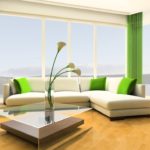Interior design can feel overwhelming when faced with the myriad of choices available. The process doesn’t have to be daunting when you break it down into the smaller components of mood, harmony and function. The three, when addressed and used effectively, can lead to a successfully designed space.
First, what’s the mood of the room you want to create? Is it a restful and peaceful bedroom, a bright and cheery child’s room, a sophisticated formal dining room or a masculine man cave with all the right gadgets? Mood is what sets the tone of the space. Mood is what affects us when we enter the room and, if done right, it reaches us emotionally and aesthetically. Think of a space you’ve visited or seen in a photo or on film and the mood came through the various combined elements. It spoke to you and touched something internally–either it excited you, created a sense of calm, or perhaps agitated you or made you uncomfortable. Mood is a key component to design and many of us forget to consider the feeling we want to experience when in a specific space.
Next we need to consider the function of the room. How do we plan on using the room–is it for arts and crafts, is it for sleeping, work, reading, storage? We need to consider this because many times we create rooms that don’t consider how the area will function and then find ourselves at odds with how the space is utilized. We have a dining room table covered with papers and kid’s school work, a bedroom that’s become part storage and part work space, an office that houses kid art and other paperwork, a living room filled with sports equipment and bikes, and is not a place to gather and relax. When planning a room, we need be aware of the function of that room so we plan accordingly and think ahead as to how many different functions a room will take.
The third element to consider is harmony. How are the furniture, paint colors, window treatment, flooring and accessories working together? Do they harmonize, ie, do they create a cohesive story that makes sense or are they out of place, not gelling, disjointed and cacophonous? Too often people have colors and styles that don’t merge. They don’t connect to one another and instead compete and create a sense of disharmony and separation. The mood is affected when the pieces don’t converge. Each element needs to be addressed individually as well as chosen with consideration to the rest of the components of a room. Without this consideration, it’s like picking clothes from a closet in the dark–they will likely be mismatched and create an unpleasant effect. When considering the flooring, are we thinking if it will work with the undertones of the walls and will it work with the wood tones of the furniture and draperies? Is the artwork adding to the space’s appeal or detracting from it and looking out of place and uncomfortable? The parts create the whole and they need to work in unison so they don’t clash and fight against each other.
By taking these points into consideration, we save ourselves a lot of wasted time and expense. We will have the overarching structure and foundation for how best to approach a space and what elements we need to contemplate in order to create the living and work areas that work effectively, that aesthetically empower us and whose parts contribute to a whole that is both harmonious and functional.

